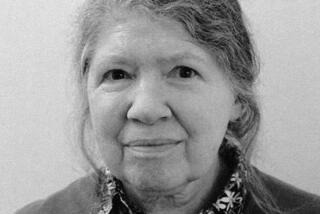I See a Long Journey: : <i> Three Novellas by Rachel Ingalls (Simon & Schuster: $14.95; 141 pp.) </i>
- Share via
Rachel Ingalls is a master storyteller whose style can be deceptively tepid and episodic as she engages the reader in the deadly habituation of someone’s casual life style, only to rush the reader to a sudden climax that is as inevitable as it is bewildering. In her title story, “I See a Long Journey,” she describes a young woman who marries into a family of considerable means, and she conveys the subtly corrosive nature of compromise:
“She moved through the round of public and domestic duties as calmly and gracefully as a swan on the water. But the serenity of her face was like the visible after-effect of an illness she had survived; or like a symptom of the death that was to follow.”
The young woman and her husband make a visit to a child goddess in a foreign land who has powers of prophecy but at puberty will be ostracized as soon as she returns to the real world. This is the metaphor for the story, and all hell breaks loose when Flora discovers she has sexual feelings for Michael, her husband’s chauffeur-bodyguard. The placid style suddenly, imperceptibly accelerates to a hallucinatory frenzy, erupting into melodrama in a dazzling shoot-out climax. In the last instant, Flora realizes that in this despicable world, wives and lives are interchangeable, and she is completely dispensable. The effect is stunning, disquieting, awful.
In the story, “On Ice,” Beverley, engaged to be married, meets Martha Torrence, an older woman in her 80s. Beverley recalls that 10 years ago she attended Martha’s funeral, and the truth comes out that these old folk have created a scam to rip off life insurance companies by arranging false deaths. Anyone who tries to leave or break secrecy about the scheme has to be disposed of on the snowy slopes, and Beverley is confined as a party to the secret, never to leave.
The last story, “Blessed Art Thou,” is in the best tradition of medieval gesta or French contes and fabliaux and is worthy of Ovid or Boccaccio. Brother Anselm in a monastic order has a vision of the naked angel Gabriel.
The angel kisses Anselm, hugs him, begins to undo his clothes and Anselm quickly takes him off to his cell where they make love. Then the angel disappears.
Anselm goes to a fellow monk who asks him, “Have you sinned?” and Anselm answers, “And how.” The monastery is in an uproar; Anselm is confined to quarters where he loses his beard, begins to grow breasts and becomes conspicuously pregnant. One monk sighs,
“Oh Christ,” Frederick said. “Years clawing my way up the ladder, being polite to creeps and crazies, and playing along with the whole business: You do me a favour, I’ll do you a favour. And then I got my own team and whipped it into shape. I worked like hell on this place, you know that. Not that they’d actually let me have it for my own--no, I’m only the deputy that makes it less trouble for them. And now this happens.”
The story builds to a final transfiguration that is stunning and unexpected, and the entire tale is an allegory of--what? Repression? Hypocrisy? Or true sanctity?
In all these novellas, the gait is easy, as casual masks are stripped away and the unconscious Furies rush in to claim their prey. Ingalls is a superlative writer, careful in her craft and awesome in her effects.
More to Read
Sign up for our Book Club newsletter
Get the latest news, events and more from the Los Angeles Times Book Club, and help us get L.A. reading and talking.
You may occasionally receive promotional content from the Los Angeles Times.









